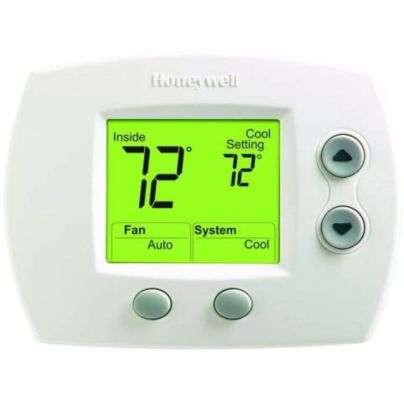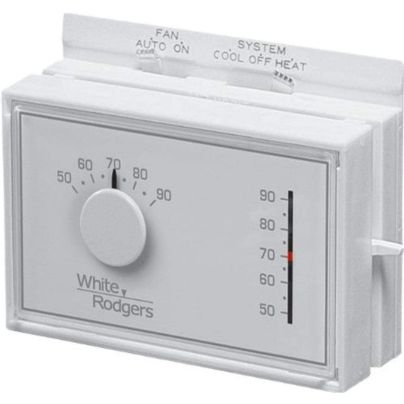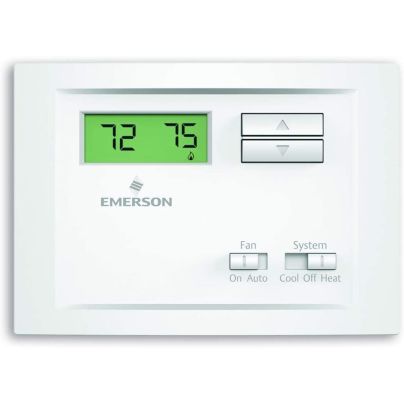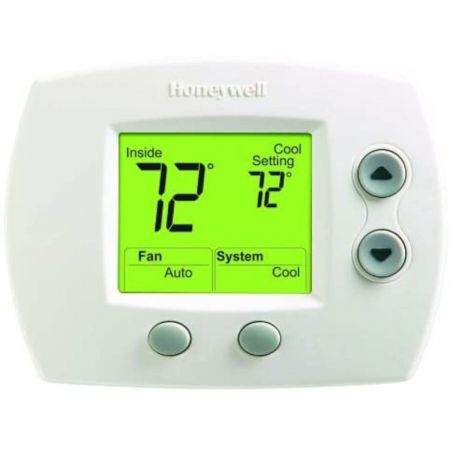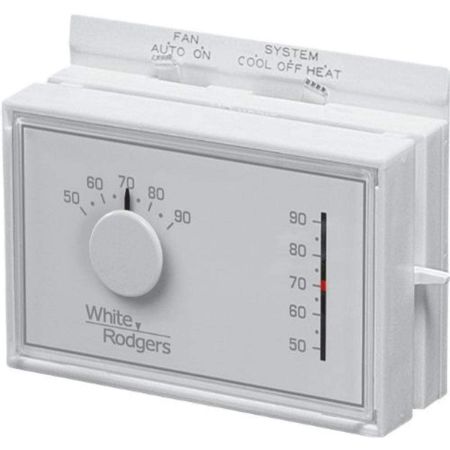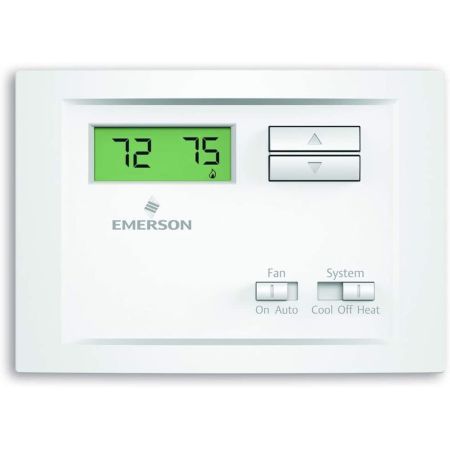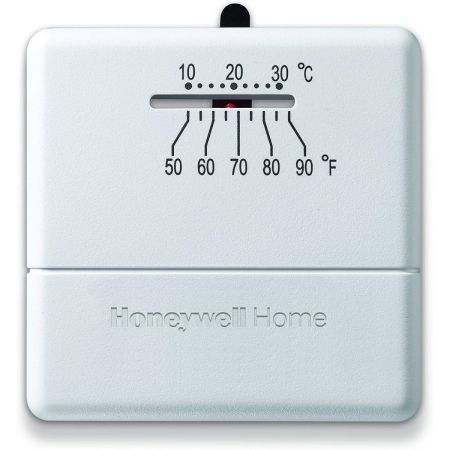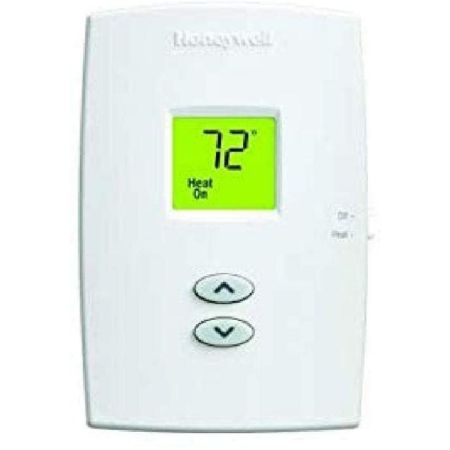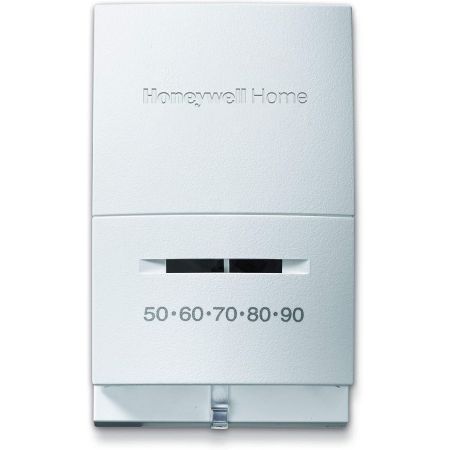We may earn revenue from the products available on this page and participate in affiliate programs. Learn More ›

Heating and cooling a home has been a primary concern for human beings since the days of open-hearth fires. But it’s only been since the 1960s that HVAC (heating ventilation and air conditioning) technology has been advanced enough to give homeowners complete control over their home’s temperature.
The thermostat is the most commonly contacted portion of an advanced HVAC system. Finding the best non-programmable thermostat for a home means considering several technological factors. Read on to learn more about finding the best possible unit for your home.
- BEST OVERALL DIGITAL: Honeywell TH5110D1006 Non-Programmable Thermostat
- BEST OVERALL MANUAL: White-Rodgers Emerson 1F56N-444 Mechanical Thermostat
- BEST BUDGET DIGITAL: Emerson NP110 Non-Programmable Thermostat
- BEST BUDGET MANUAL: Honeywell Home CT30A1005 Standard Manual Thermostat
- BEST HEAT-ONLY DIGITAL: Honeywell TH1100DV1000 Nonprogrammable Thermostat
- BEST HEAT-ONLY MANUAL: Honeywell Home CT50K1002 Standard Heat Thermostat
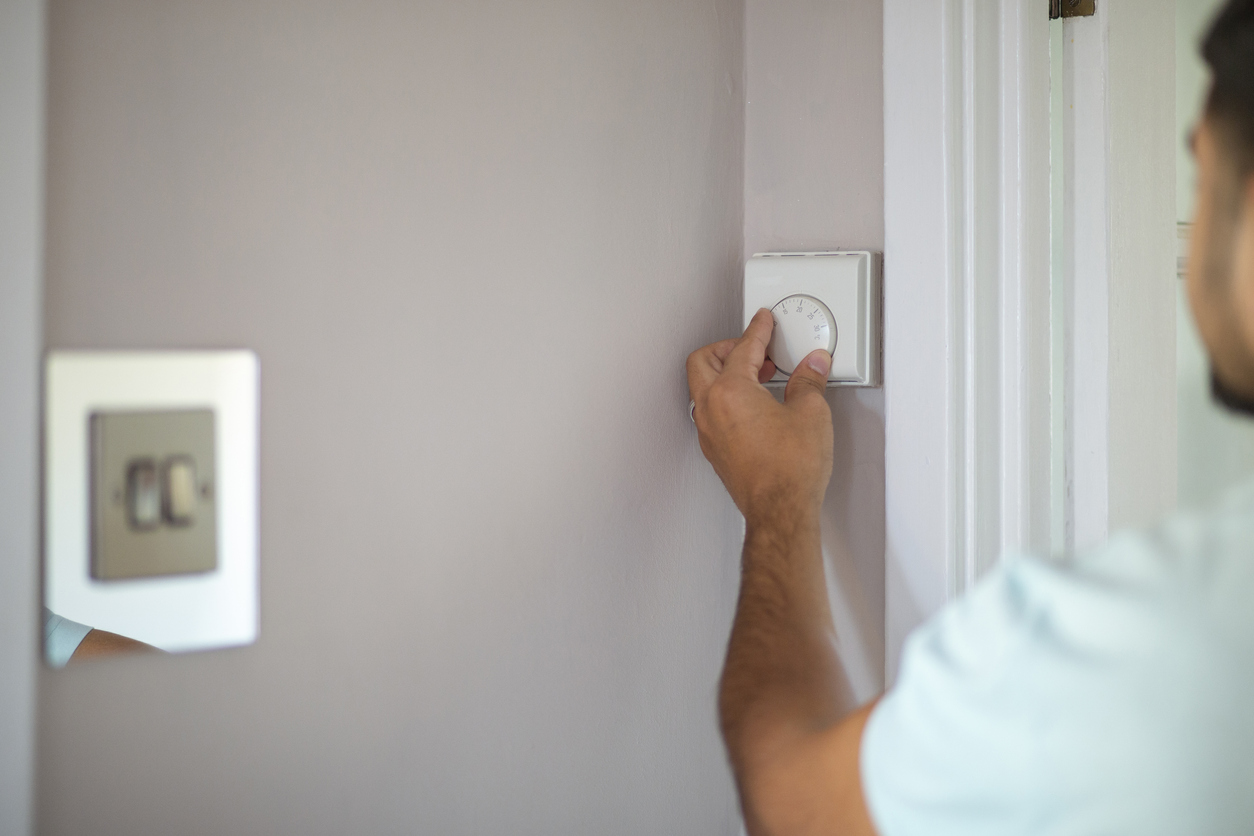
What to Consider When Choosing the Best Non-Programmable Thermostat
Identifying the best non-programmable thermostat requires taking several factors into account. The location, display, power source, capability, additional features, and other considerations of a thermostat make the difference between having trouble-free operation and home temperature woes. Below is a quick summary of some of the most important characteristics to consider when selecting the best non-programmable thermostat for a home.
Location
Selecting the proper location for the thermostat is integral to optimum performance. The best non-programmable thermostat should be located centrally. In addition to being convenient to multiple locations, a centrally located thermostat will take the best readings of the home’s average temperature.
Thermostats located in sunny areas will read temperatures that are higher than the actual temperature in the home. Similarly, thermostats should not be placed near air vents, as the flowing air may cause inaccurate temperature readings because hot air rises and cool air drops. Installing the thermostat 52 inches to 60 inches from the floor will give the best average reading. Placing a thermostat incorrectly may result in the user adjusting the temperature based on flawed data.
Manual vs. Digital
The world is becoming increasingly digital—and for good reason. Digital thermostats offer several advantages over manual thermostats. In addition to providing a sleek and modern addition to the home, digital thermometers save up to 10 percent in energy savings over the year due to superior sensors and efficiency settings. These energy savings are offset by the fact that the initial cost of digital thermometers tends to be higher than their manual counterparts.
A manual thermostat looks more old-fashioned than a digital one. It is operated by mechanical knobs or switches to achieve the desired temperature. While the aesthetics of a manual thermostat may complement a home’s interior, they also offer drawbacks. They tend to be imprecise when compared to digital, so while manual thermostats cost less at purchase, they may result in higher yearly energy costs because they lack refinement.
HVAC System Compatibility
Not all HVAC systems are the same. Heat pumps, furnaces, baseboard units, and air conditioning units all have different electrical requirements and sometimes use single- or multistage speed systems. The majority of systems fall into low-voltage or high-voltage categories.
The best way to check if a thermostat is compatible with the existing HVAC system is to determine the wiring requirements of the system. Shut off the power to the HVAC system before removing the cover of the thermostat or HVAC unit. Low-voltage systems use thinner wires, while high-voltage systems have thicker wires and usually include high-voltage warnings on the equipment. Always exercise caution when determining compatibility and performing an installation of a thermostat or consult a professional electrician.
Power
Like everything else in the home, thermostats need a dedicated power source to operate. This power source may derive from the HVAC unit, the home’s existing electrical system, or from a battery.
Hardwired thermostat systems are tied directly into the home’s electrical infrastructure through a dedicated wire known as the C-wire. A C-wire provides a connection directly to the HVAC system so that as long as a home has power, the thermostat does as well.
Battery-powered units are most often found on digital thermostat systems. The advantage of a battery-powered thermostat is that it will still operate during a power failure—though your HVAC system is not likely to function without a power source unless there is a backup generator for emergencies.
Dual-power systems are a combination of the directly tied-in C-wire with a battery backup in case of emergencies. These are the most effective systems as they cover all eventualities.
Display and Controls
The proper display and control features could spell the difference between easy, precise operation and confusing temperature mishaps. Consider characteristics like backlighting, display information, and ease of use when identifying the best non-programmable thermostat for your home.
Digital thermostats employ large backlit screens that display temperature information similar to that of a digital watch. On more sophisticated units, displays may offer more information on colorful displays similar to a smartphone screen. Aside from temperature, displays may show humidity, fan speed, time, and even external weather conditions.
By nature, manual displays are more utilitarian. They often display temperature via a dial similar to an analog watch: a needle or a set of needles encased in glass point to the home’s approximate temperature. Manual displays have fewer features and tend to be less accurate than digital displays.
Additional Features
Though non-programmable thermostats tend to be more rudimentary than their smart-enabled cousins, there are still a few useful features that provide extra utility to basic thermostats.
One of the most user-friendly features is proper backlighting. Changing the temperature in a dark room—especially with manual thermostats—can be challenging. A backlit display is crucial for easy operation at night.
Digital displays offer more in the way of features. Keypad lockouts prevent children or guests from changing the temperature against your wishes. Some digital thermostats also include touch screen capability and displays that provide information about humidity levels or outdoor weather conditions.
Installation
Installing a thermostat can be potentially dangerous due to the electrical voltage running through the unit. Before attempting any installation, make sure to turn off the power to that area of the home via the fuse panel. Consulting a professional electrician will help ensure a safe and straightforward installation process.
The good news is installers do not need a lot of specialized knowledge; replacing a thermostat is a relatively simple process. After turning off the power:
- Remove any existing thermostat by removing the screws securing the faceplate.
- Label the wires using masking tape before disconnecting them from the thermostat body, then match up the corresponding wire entry points on the new thermostat to the existing cables.
- Simply mount the new thermostat to the wall by pressing the unit into the hole and reconnecting the faceplate.
- Turn the power back on, and enjoy your new thermostat.
When in doubt, consult a professional for help to install the new thermostat safely.
Our Top Picks
Identifying the best non-programmable thermostat for a home can be a labor-intensive task. This list of some of the best options on the market takes the guesswork out of thermostat shopping. Read on to learn more about which products may best fit your temperature-regulating goals.
Best Overall Digital
Honeywell TH5110D1006 Non-Programmable Thermostat
See ItHoneywell’s classic white non-programmable thermostat can blend in seamlessly to a home’s interior design. Measuring 4.5 inches by 1.5 inches by 3.4 inches in a curved rectangular shape, it features a sleek design without taking up too much space. The brightly backlit 1.5-inch screen is easy to read in the dark, and its four large buttons make operation clear and simple.
The TH5110D1006 model is dual-powered, meaning it can be hardwired into the home’s electrical system, and it offers a battery backup fueled by a pair of AA batteries. It is compatible with a heat pump or a single conventional HVAC system.
Pros
- Sleek design
- Clear and simple operation
- Dual-powered
- Includes battery backup
Cons
- Slow temperature reaction
Best Overall Manual
White-Rodgers Emerson 1F56N-444 Mechanical Thermostat
See ItWeighing in at 4.5 ounces and measuring 2.75 inches by 4.5 inches by 1.5 inches, White-Rodgers Emerson’s mechanical offering may be one of the best non-programmable thermostat options. Three mechanical switches allow users to easily set their HVAC system’s fan and temperature by feel. Enclosed electrical contacts help guarantee reliability and accuracy.
The 1F56N-444 model is compatible with gas, oil, and electric single-stage HVAC systems and regulates temperatures in the 50-degree to 90-degree Fahrenheit range. The built-in bimetal thermometer reads the home’s temperature. This unit does not offer battery backup. This thermostat is an excellent choice for those seeking mechanical simplicity and fuss-free operation.
Pros
- Simple setup/use
- Built-in bimetal thermometer
- Reliable and accurate
Cons
- No battery backup
Best Budget Digital
Emerson NP110 Non-Programmable Thermostat
See ItThis digital thermometer gets the job done without breaking the bank or offering too much in the way of extraneous features. While slightly larger than other models, the NP110 model measures 1.5 inches by 6 inches by 4 inches and is available in a neutral white that blends well with most surroundings. The backlit digital display is not huge but provides ample space for essential information.
The four simple mechanical switches eliminate some touch screen systems’ touchiness and provide precision temperature adjustments of 1 degree Fahrenheit. The NP110 model is compatible with single-stage heating, cooling, and heat pump systems that do not employ auxiliary backups. It will not function properly with multistage systems or with 120/240-volt electric baseboard heaters.
Pros
- Affordable
- Easy to use
- Precise
Cons
- Small digital display
- Does not function with multistage systems
Best Budget Manual
Honeywell Home CT30A1005 Standard Manual Thermostat
See ItHoneywell’s manual budget thermostat works with low-voltage heating systems. A snap action switch makes operation as easy as flipping a piece of plastic, and the temperature feedback is measured by a bimetal mercury-free sensor that makes it easy to discern which setting is selected. Controls couldn’t be more straightforward: A single mechanism adjusts temperature with the flick of a finger.
A bimetal temperature sensor reads the room’s temperature and provides feedback through the mechanical indicator. Measuring 0.88-inch by 3.12-inches by 3.12-inches, this non-programmable thermostat has a small wall footprint and comes in a neutral white that does not impose on home decor. This thermostat is for “heat only” systems and will not control air conditioning systems.
Pros
- Easy to use
- Affordable
- Straightforward controls
Cons
- For heat-only systems
Best Heat-Only Digital
Honeywell TH1100DV1000 Nonprogrammable Thermostat
See ItThis “heat only” non-programmable thermostat from Honeywell offers simple controls and a brightly lit display for easy installation and operation. It displays the home temperature and system status at all times. Two buttons and a single switch are as complex as the controls get. This thermostat will bring temperatures to as low as 40 degrees Fahrenheit or to as high as 90 degrees Fahrenheit.
Measuring 4.69 inches by 2.88 inches by 1.13 inches, its slightly curved vertical rectangular shape offers a small footprint and neutral design cues suitable for any home. It is powered purely by a pair of AA alkaline batteries, so hardwiring this thermostat is not an option. This thermostat is designed for heat systems only and will not operate air conditioning units.
Pros
- Brightly lit display
- Easy to use
- Wide range of temperature options
Cons
- Must change temperature to see backlit display
Best Heat-Only Manual
Honeywell Home CT50K1002 Standard Heat Thermostat
See ItIf a “heat only” manual thermometer is required, look no further than Honeywell’s CT50K1002 thermostat. A classic neutral design combines with a sizable footprint in this 11-inch by 9-inch by 4-inch non-programmable thermostat. With only a single control input, this thermostat is the ultimate in easy use. A mercury-free thermometer regulates home temperature.
The kit includes everything required for wall mounting and the unit can be hardwired into the home’s power system. Batteries are not an option for this unit, so if a dual-power option is a requirement, look elsewhere. The CT50K1002 model is compatible with central gas or oil heating systems.
Pros
- Easy to use
- Mercury-free thermometer
- Includes materials for wall mounting
Cons
- Not dual-powered
Our Verdict
A non-programmable thermostat makes a great and convenient addition to any home that needs temperature control. Not only are they cheaper but they’re also less complex and easier to install and operate than their programmable counterparts. We chose the Honeywell TH5110D1006 Non-Programmable Thermostat as our top pick for homeowners who want an affordable, dual-powered thermostat. Its sleek design, bright digital display, and easy-to-use features are a great option for any home.
How We Chose the Best Non-Programmable Thermostats
There are many different types and styles of thermostats on the market. Many homeowners tend to search for non-programmable thermostats, as they’re the most convenient and affordable option without compromising any essential basic features.
When we chose our best picks for non-programmable thermostats, we considered factors like HVAC system compatibility; whether they were digital, manual, or mechanical; display and control options; and ease of installation. All our best picks offer a seamless user experience for homeowners.
Our recommendations are all easy to use, affordable, have a simple setup process, and provide accurate readings. In fact, they’re all extremely precise and ensure users will be shown the right temperature within just 1 degree. Additionally, they tend to blend into the background of any home so as not to disrupt aesthetics or appear bulky. While some of these options are only compatible with heat-only systems, others on the list accommodate AC and heat systems and still offer great features at an affordable price.
Depending on how much a homeowner is willing to pay, and which type of non-programmable thermostat (digital, manual, or mechanical) they want, there are plenty of quality options available to easily keep a home’s temperature under control. Installation is quite straightforward, so after purchasing a non-programmable thermostat, simply cut power to the area and install your power wires to the new thermostat.
FAQs
There is a lot to consider when choosing the best-non programmable thermostat. For a quick reference to some of the most pressing queries, check out the answers to these frequently asked questions.
Q. What is the benefit of purchasing a non-programmable thermostat instead of a programmable model?
Non-programmable thermostats are usually less complex and easier to operate and install than their programmable counterparts. Additionally, they tend to be cheaper.
Q. What is the downside to a non-programmable thermostat?
A non-programmable thermostat does not allow the user to program temperature changes without manual input, and it also lacks the remote capability of a smart device.
Q. How is a non-programmable thermostat installed?
Installation is relatively straightforward:
- Cut power to the area.
- Remove the faceplate with a screwdriver.
- Remove and label the power wires.
- Install the power wires to the new thermostat.
- Reverse the uninstallation process and restore power.
Why Trust Bob Vila
Bob Vila has been America’s Handyman since 1979. As the host of beloved and groundbreaking TV series, including This Old House and Bob Vila’s Home Again, he popularized and became synonymous with “do it yourself” home improvement.
Over the course of his decades-long career, Bob Vila has helped millions of people build, renovate, repair, and live better each day—a tradition that continues today with expert yet accessible home advice. The Bob Vila team distills need-to-know information into project tutorials, maintenance guides, tool 101s, and more. These home and garden experts then thoroughly research, vet, and recommend products that support homeowners, renters, DIYers, and professionals in their to-do lists.
Mike Bruton is a former carpenter turned copywriter and novelist. When not writing, Mike is surfing as much as he can along the coast of Charleston, South Carolina.
